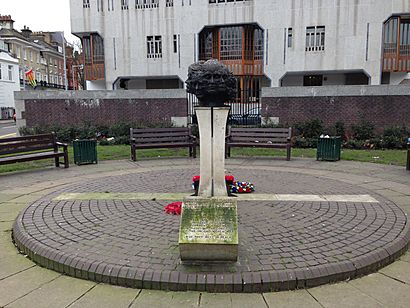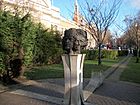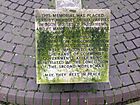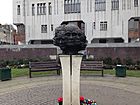Twelve Responses to Tragedy facts for kids
Quick facts for kids Twelve Responses to Tragedy |
|
|---|---|

The memorial in January 2016
|
|
| Artist | Angela Conner |
| Year | 1986 |
| Type | Sculpture |
| Medium | Bronze |
| Location | London, United Kingdom |
The Twelve Responses to Tragedy, also called the Yalta Memorial, is a special monument in London. It is found in the Yalta Memorial Garden on Cromwell Road in South Kensington. This memorial remembers many people who were forced to leave their homes. This happened after the Second World War because of an important meeting called the Yalta Conference.
The memorial was made by a British artist named Angela Conner. It has twelve bronze faces on top of a stone base. It was put in place in 1986. This new memorial replaced an older one from 1982, which had been damaged many times.
Contents
Where is the Yalta Memorial?
The memorial is in the Yalta Memorial Garden. This garden is where Cromwell Gardens, Thurloe Place, and Thurloe Square meet. It is right next to the Victoria & Albert Museum. You can visit the garden and the memorial any time.
Why was the memorial built?
The idea for a memorial started in the 1970s. Some writers suggested building a monument. They wanted to remember the many innocent people who were sent back to the Soviet Union and Yugoslavia. This happened at the end of the Second World War. Many people felt this was a secret and unfair act.
Later, more people, including politicians and writers, supported the idea. They wrote letters to newspapers asking for a memorial. In 1978, they started asking for money to build it.
Approval and the first memorial
The Prime Minister at the time, Margaret Thatcher, approved the memorial in 1980. However, some government departments, like the Foreign Office, were against it. They did not want a monument on government land that seemed to criticize past actions of the British government.
The first memorial was a fountain with stone benches. It was also made by Angela Conner. The Bishop of London, Graham Leonard, officially opened it on March 6, 1982. Both the government of the Soviet Union and the British Foreign Office did not want this memorial to be built.
The new memorial
Sadly, the first memorial was damaged many times. It was completely broken in 1982. So, people decided to build a second monument. Angela Conner helped raise money by selling special pictures she had made.
Conner's second memorial, Twelve Responses to Tragedy, was put in the same spot. It was officially opened on August 2, 1986. The Bishop of Fulham, John Klyberg, led the ceremony.
What does the memorial look like?
The first memorial was a sphere that moved with water jets. The current memorial is a stone column on a brick base. On top of the column, there is a bronze sculpture. It shows 12 faces of men, women, and children joined together.
There are also important messages carved into the stone. One message explains that this sculpture was put here to replace the first one. It says the first memorial was destroyed by people who did not want the truth to be known.
Another message on a curved stone says: "This memorial was placed here by members of all parties in both houses of the Parliament and by many other sympathisers in memory of the countless innocent men women and children from the Soviet Union and other East European states who were imprisoned and died at the hands of Communist governments after being repatriated at the conclusion of the Second World War. May they rest in peace."
Prime Minister Margaret Thatcher personally approved these words. This memorial is seen as a war memorial. It remembers events that happened because of the end of the Second World War.
Gallery




